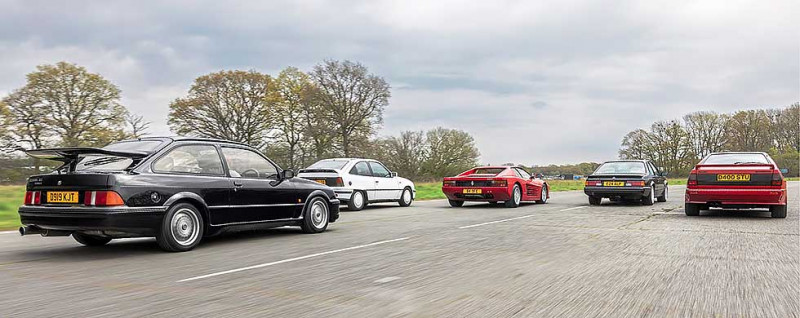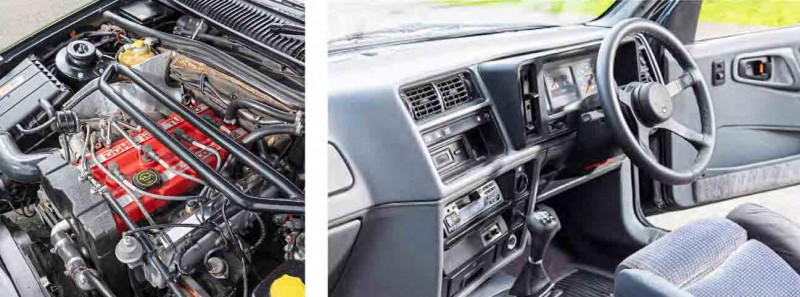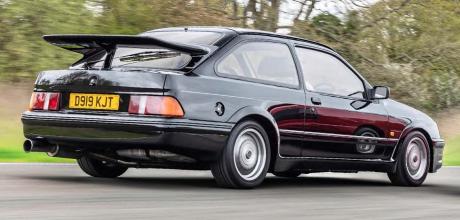1986 Ford Sierra RS Cosworth
It’s likely that among the cars we have here, for those of a certain age at least one bounces off the page, rebounds off memories of teenage bedroom walls and slams straight into your affections. Hands down, for me it’s the Cossie. Not for me Porsches, Ferraris or Lambos. For many others it was the same – why? Because this was a Ford Sierra – a car that, albeit initially unloved, swiftly became as much a staple of British life as Woolworths and Bullseye. Only this Sierra had a turbocharged fourpot and a rear wing seemingly large enough to perch Concorde on. Oh, and with some relatively minor modifications, could be tuned to 350bhp and beyond, blowing automotive exotica into the weeds.
It looks so extreme from the outside – even today, it shocks, looking like Darth Vader’s wheels, smack-era Depeche Mode in wheeled form. It’s an illusion that’s almost immediately shattered as soon as you open the door. There’s no escaping the Sierra origins of the dashboard of course, though the comfortable cloth Recaro seats and perfect-thickness steering wheel brighten things up a touch. This is, after all, a car built to homologate racing car successes, much to the chagrin of the Ford dealer and marketing teams. They couldn’t fathom how they’d sell the necessary 5000; in the end it was a sales success.
For all the dreams of podiums, the car still had to be… well, a Ford. That means it had to be actually usable if your name wasn’t Andy Rouse, and what quickly becomes apparent is just how soft, malleable and easygoing the Cosworth is. It’s not hard to imagine covering many thousands of working miles in the spacious, light cabin (well, if it wasn’t nicked in the meantime) just like a 1.3 GL. However, all it takes is a cursory glance in the rear-view mirror at the rear spoiler to remind me that this isn’t a normal Sierra – and, suitably for the era, this particular example isn’t a normal Sierra Cosworth...

This car has been treated to a Garrett T34 hybrid turbocharger, Group A-specification cylinder head gasket, dump valve and more besides, resulting in a Porsche 930 Turbo-trumping 360bhp – all in a vehicle that weighs just 1220kg. Full-bore acceleration is sternum-crushingly intense – in an era of obese hyper-horsepower hot hatches, I reckon this Cossie could still show them up in a straight line.
In the corners? Perhaps not. Even with this particular one’s upgraded Koni suspension, front and rear strut braces and extensive poly-bushing, the car still rolls heavily into and out of corners, squatting on its haunches on corner exit. There’s not a great deal of feel through the steering wheel and the gear throw is long and somewhat loose.
Does this detract from the experience? Not a single iota. The coarse rasp of a boosted Pinto through a fat exhaust pipe raises a fantastically raucous middle finger to polite society. Imagine Stakker Humanoid as a car and you get the idea. It may not be a nuanced experience, but when the turbo fires it’ll leave you gurning in delight like a 1988 warehouse raver.
Of all the cars here, it’s the Cosworth that has people reaching for their smartphones, men of a certain age chucking their heads out of their side windows like a Labrador in search of dropped BBQ sausages. That’s because the Sierra Cosworth is not really a car, it’s a folk hero, which is where we came in. This was the attainable dream, the Ferrari-crushing supercar for the man on the streets. Perhaps not now, though. Fast forward to today and that chap on the pavement will have to cough up at least £50k for a three-door Cosworth like this. This one sold via The Collection (thecollectiongb.com) for £59,950. Fancy one yourself? Take an expert to check you’re looking at genuine one and that the car hasn’t been subject to a lamp-post redesign at some point. Rust can run rampant all over the car, too.
Then there’s the thorny tuning conundrum. Traditional classic car world wisdom is that originality is best – and that is where the big money is if you’ve an eye on future return. The thing is – and this is a personal view – that undermines the very appeal of the Cossie. Tweaking, tuning and modifying, then blowing away the opposition was at the heart of the bewinged king of the suburban dual carriageway legend. Having experienced the whip-crack whoosh of today’s tastefully tickled example, it still reigns supreme.
Owning a Ford Sierra RS Cosworth
Neil Winn has had his three-door Sierra Cosworth (not the one pictured here) for six years, and paid £32,000 for it. ‘It was quite heavily modified when I bought it – a chromed engine bay, big wheels, big brakes – I put it all back to standard,’ he says. This process cost him £6000, but he recouped half of this selling the aftermarket parts. Since then he’s had to pay around £300 per year in maintenance, though it helps that he’s a mechanic by trade.
The downside? ‘It’s a nightmare to find original parts,’ he says. ‘I offered a guy £1400 for a new header tank and he turned me down, and a pair of NOS (new old stock) headlamps was £1000.’ Neil cites Graham Goode Racing as a good source for parts and specialist services. Neil loves the car’s easy maintenance – and loves the looks even more.
TECHNICAL DATA 1986 Ford Sierra RS Cosworth
- Engine 1993cc inline four-cylinder, DOHC, Garrett T3 turbocharger, Weber Marelli Multipoint fuel injection
- Max Power 204bhp @ 6000rpm
- Max Torque 204lb ft @ 4500rpm
- Transmission Five-speed manual, rear-wheel drive
- Steering Power-assisted rack and pinion
- Suspension Front: independent, MacPherson struts, twin-tube telescopic dampers, coil springs, anti-roll bar. Rear: independent semi-trailing arms, coil springs, telescopic dampers, anti-roll bar
- Brakes Front: vented discs; Rear: discs, ABS Bosch
- Performance Top speed: 143mph
- Acceleration 0-60mph: 6.2sec
- Weight 1220kg (2690lb)
- Cost new £15,995
- CC Price Guide £18k-£50k

Hardcore looks belie Sierra’s placid nature. Twin-cam head and turbo at the heart of Cosworth magic. Sports wheel and seats, otherwise pure repmobile.
‘When the turbo fires it’ll leave you gurning in delight like a 1988 warehouse raver’


